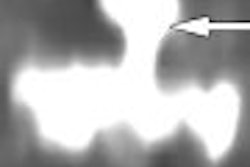The use of dual-phase PET/CT can help distinguish benign from malignant lung nodules when F-18 FDG uptake is low, according to a new study from Korea.
The intensity of F-18 FDG uptake is influenced by "biologic nature, size, variation in body habitus, duration of uptake period, and plasma glucose levels," said Dr. Me Seong Yi from the National University of Pusan. Low F-18 FDG uptake in some tumors can make it "difficult to distinguish benign from malignant" findings noninvasively, she noted.
Yi and colleagues sought to assess the utility of dual-phase PET/CT to differentiate benign from malignant lung diseases with low F-18 FDG uptake. Yi presented her team's results at the 2007 European Congress of Radiology (ECR) in Vienna.
From a cohort of 218 patients who underwent PET/CT (154 men, 64 women; ages 25-83, mean 60), 73 patients had focal lung lesions with a standardized uptake value (SUV) of less than 2.5 at PET/CT (60-minute delay), and 43 did not undergo follow-up imaging.
The remaining 30 patients were analyzed to assess the utility of dual-phase PET/CT at two time points: the first scan at 60 minutes and a second scan 120 minutes after the injection of F-18 FDG.
CT images were acquired on a four-slice as well as a 16-slice multidetector-row scanner (LightSpeed QXi , GE Healthcare, Chalfont St. Giles, U.K.), Yi said.
The researchers measured maximum and mean SUV, as well as maximum and mean lesion-to-normal-tissue ratio (LNR) for each scan time. Changes in SUV and LNR between the first and second scans were calculated for each patient by comparing the areas under the curve (Az). Finally, chi-square and Mann-Whitney tests were performed to differentiate between malignant and benign lesions, Yi said.
The results showed 13 malignant and 17 benign lesions. In all, 17 had a histopathologic diagnosis (13 malignant, four benign). Thirteen lesions did not undergo histopathologic diagnosis (10 had no change, three were smaller), but were followed up with CT over the course of a year or more.
The 13 malignancies (8.9-29 mm in diameter) included eight adenocarcinomas (12.4-29 mm), one small cell lung cancer (16.8 mm), two squamous cell carcinomas (8.9 and 13.1 mm), and one 13.3-mm adenoid cystic carcinoma metastasis, Yi said.
At ROC analysis, Az for distinction of malignant and benign lesions were 0.824 in maximum SUV for scan 2, 0.842 in maximum LNR for scan 2, 0.814 for mean LNR of scan 2, and 0.810 for the change of SUV.
In fact, statistically significant differences were seen "in most measures," Yi said, including the maximum SUV of scans 1 and 2, in the mean SUV of scans 1 and 2, in the change of maximum SUV, in maximum LNR of scans 1 and 2, and in mean LNR of scans 1 and 2 between malignant and benign lesions (all p < 0.05).
"We also compared (uptake for) benign and malignant nodules, most showing significant p values," Yi said. Especially remarkable were the differences between 60- and 120-minute scan delays for maximum SUV (1.75 versus 2.82) and maximum LNR. "Delayed-enhancement PET/CT is useful for distinguishing benign from malignant lesions," she concluded.
An audience member cautioned that most of the lesions in the study were 1-3 cm in size -- easier in general to image with F-18 FDG than the smallest nodules. Moreover, he added, there were no bronchoalveolar carcinomas, which tend to exhibit low radiotracer uptake.
New FDG-PET study for lung cancer patients
In related news, the American College of Radiology Imaging Network (ACRIN) has embarked on a new clinical trial designed to prospectively validate if FDG can serve as a predictive marker of tumor response and patient outcome in non-small cell lung cancer (NSCLC) patients.
ACRIN 6678, to be led by Dr. Wolfgang Weber from the University of California Los Angeles Medical Center, will evaluate whether a metabolic response, defined as a 25% decrease in peak tumor standardized uptake value (SUV) after the first course of chemotherapy, can predict treatment outcomes in patients with stage IIIB or IV NSCLC undergoing platinum-based chemotherapy.
A total of 228 patients will be recruited for the study, according to ACRIN.
By Eric Barnes
AuntMinnie.com staff writer
April 4, 2007
Related Reading
PET, CT CAD scheme differentiates benign from malignant lung nodules, November 28, 2006
Lung PET rules when CT is equivocal, discordant, July 12, 2005
CT and PET screening useful in detecting early lung cancer, June 15, 2005
PET/CT provides cost-savings for NSCLC radiotherapy, July 4, 2005
PET/CT demonstrates staging strength over PET, CT, and PET plus CT, March 7, 2005
Copyright © 2007 AuntMinnie.com




















